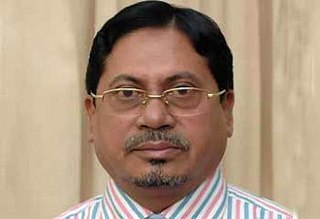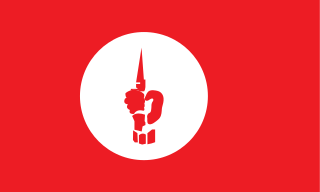
Muhammad Kamaruzzaman was a Bangladeshi politician and journalist who served as the senior assistant secretary general of Bangladesh Jamaat-e-Islami and was convicted of war crimes during the 1971 Liberation war of Bangladesh. He was executed by hanging at Dhaka Central Jail at 22:01 on 11 April 2015.
Kader Bahini was an independent militia created during the Bangladesh Liberation War of 1971, the other being Mukti Bahini. It was named after its leader, Kader Siddique.
Burunga massacre was a massacre of at least 71 members of the Hindu population of Burunga and nearby villages on the Burunga High School grounds, in the district of Sylhet by the Pakistani army on 26 May 1971.
Galimpur massacre was a massacre of the Hindu population of Galimpur in the district of Sylhet by the Pakistani army on 20 May 1971.
Akhira massacre was a massacre of the emigrating Hindus of the then Dinajpur district near Baraihat on 17 April 1971 by the Pakistani army with collaboration from the local Razakars. It is estimated that around 100 Hindus were killed in the massacre.
Makalkandi massacre was a massacre of over 40 Bengali Hindus of the Makalkandi village in the Habiganj Sub-division of undivided Sylhet district of East Pakistan by the Pakistani army on 18 August 1971.
Karai Kadipur massacre was the massacre of unarmed Hindu villagers of Joypurhat on 26 April 1971 by the Pakistani army and the Razakars. 370 Hindus were killed in the massacre in the villages of Karai, Kadipur and other adjoining villages.
Muzaffarabad massacre was the massacre of the residents of predominantly Hindu village of Muzaffarabad now under Kharna Union of Patiya Upazila in Chittagong District of Bangladesh on 3 May 1971 by the Pakistani army aided by the local collaborators. An estimated 300 Bengali Hindus, from 5-year-old child to 80 years old men and women were killed in the massacre. More than 500 houses were burnt to ashes. According to eyewitnesses, Rameez Ahmed Chowdhury, the then Chairman of Kharna Union, and his aides were responsible for the massacre.
The Madhyapara Massacre was the massacre of over 370 unarmed Bengali Hindu residents of Madhyapara and other nearby villages under the authority of the Palong police station in the Faridpur district of East Pakistan, by the occupying Pakistani army on 22 May 1971. An estimated 370 people were killed in the massacre. In 1971, the villages of Madhyapara, Kashabhog & Rudrakar were under the authority of the Palong police station of Madaripur sub-division in Faridpur District. They are now under the jurisdiction of the Shariatpur municipality in Shariatpur Sadar Upazila of Shariatpur District. The three villages at the time were largely Hindu-inhabited and Madhyapara was totally Hindu.
Naria massacre refers to the massacre of 28 Bengali Hindus of Naria village in the district of Sylhet in East Pakistan on 5 May 1971 by the Pakistani occupation army.

The Mukti Bahini, also known as the Bangladesh Forces, was the guerrilla resistance movement consisting of the Bangladeshi military, paramilitary and civilians during the Bangladesh Liberation War that transformed East Pakistan into Bangladesh in 1971. They were initially called the Mukti Fauj.
Shankharikathi massacre refers to the killings of unarmed Hindu men by the Razakars in Shankharikathi market, Alukdia village of greater Khulna district in Bangladesh on 4 November 1971. 42 Hindus were killed in the massacre.
Bagbati massacre refers to the killings of more than 200 unarmed Bengali Hindus by the Al Badar, Pakistan Army, Razakars and Peace Committee, in the Bagbati Union of Sirajganj sub-division in the erstwhile district of greater Pabna in May 1971. After the massacre the bodies were buried or dumped in wells.
Kaliganj massacre refers to the massacre of over 400 unarmed Bengali Hindus in East Pakistan fleeing to India in Kaliganj market, in the present day Jaldhaka Upazila of Nilphamari District on 27 April 1971. An estimated 400 Bengali Hindus were killed by the occupying Pakistan Army. It is alleged that this massacre was masterminded by Muslim League leader and central minister Kazi Abdul Kader.
Ishangopalpur massacre refers to the massacre of Bengali Hindus in Ishangopalpur village, in the outskirts of Faridpur on 2 May 1971. The Pakistan army shot and bayoneted 28 Bengali Hindus to death.
Baria massacre was the massacre of unarmed Bengali Hindus in the village of Baria in present-day Gazipur Sadar Upazila of Bangladesh by the Pakistan army on 14 May 1971. Around 200 Bengali Hindus from Baria and nearby Kamaria were killed in the massacre, while hundreds more were injured.
Hasamdia massacre was the massacre of 33 unarmed Bengali Hindus in the Hasamdia village and nearby areas of the Faridpur District of East Pakistan on 16 May 1971 by the Pakistan Armed Forces. 33 persons were killed in the massacre. On 21 January 2013, the International Crimes Tribunal adjudged Abul Kalam Azad guilty of genocide for his involvement in the massacre and sentenced to death.
Jogisho and Palsha massacre was a premediated massacre of 42 Bengali Hindus in the Jogisho and Palsha villages under Durgapur Upazila of Rajshahi Division in East Pakistan on 16 May, 1971 by the occupying Pakistan Army in collaboration with the Razakars during the Bangladesh Liberation War. According to sources, 42 Bengali Hindus were killed by the Pakistani Forces and the Razakars.
Nikli massacre was a premediated massacre of 35 Bengali Hindus in the Dampara Union of Nikli Upazila of Kishoreganj District, Dhaka Division, on 21 September 1971 by the Pakistan Army in collaboration with the Razakars during the Bangladesh Liberation War. According to sources, 35 Bengali Hindus were killed by the Pakistani Forces and the Razakars.
The Terosree massacre was the mass murder of 43 civilians by the Pakistan Army in the Manikganj District during the Bangladesh Liberation war. The name comes from the local Terosree Zamindari estate. The Hindu zamindar was killed in the massacre.


